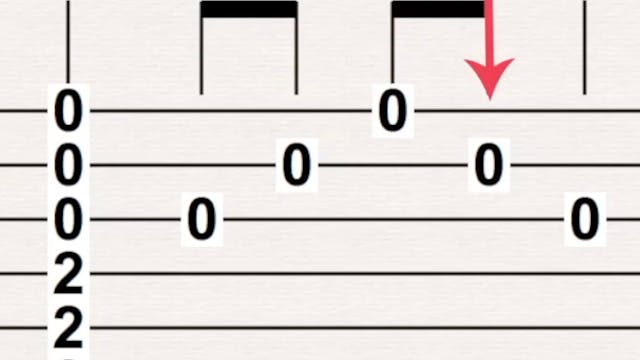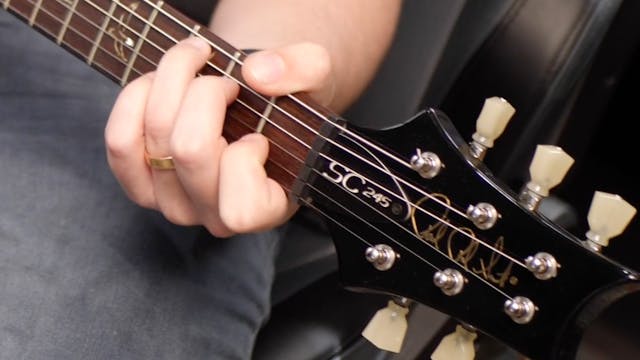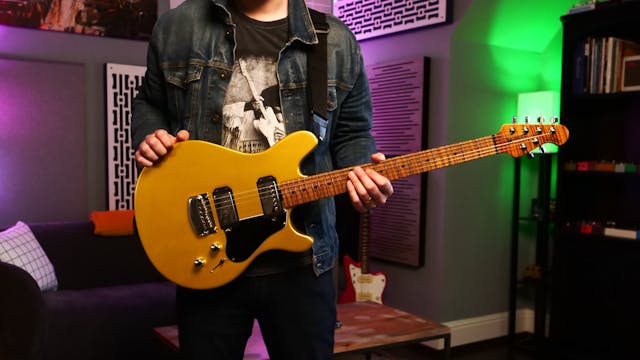Understanding the Parts of Your Guitar
Beginners Corner
•
2m 58s
We’re going to look at the different parts of your guitar first so you can understand what they do and how they can help you. Let’s begin with our volume knobs. While each guitar is different, you can be sure that every electric guitar will have at least one volume knob. You’ll notice the green guitar has two volume knobs — each one controls the volume for its respective pickup (we’ll get to pickups in a moment).
The other knobs are called tone knobs. Tone knobs control how bright or dark the sound of your guitar is by adjusting the corresponding pickup’s tone level. When you’re starting out playing the electric guitar, it’s fine to leave your tone knobs all the way up, and come back to experiment with them later after you’re more comfortable playing chords and other music.
The bridge of your guitar may look different depending on what style of bridge it is, but the bridge of the guitar always has the same function, which is to hold the strings on the body of your guitar. You’ll learn more about the bridge when we go over how to change your guitar strings in the next chapter.
Pickups are the objects on an electric guitar that sit underneath the strings between the bridge and the neck. Again, there are many different types of pickups, so they may look different depending on what kind of pickups are installed in your guitar. Pickups differentiate an electric guitar from an acoustic guitar. You can think of pickups as little magnetic microphones. They take the sound of your guitar strings, and magnify that sound through a guitar amplifier. Pickups, like your tone knobs, can make your guitar sound different.
That brings us to our pickup selector switch. Depending on the kind of electric guitar you have, the pickup selector switch may be near the top or the body of your guitar. When the pickup selector switch is in the downward position (pointing downward and away from you, that will typically give you the brightest sound. When the switch is in that position, it is utilizing the bridge pickup. Some guitars have only three positions that you can set your pickup selector switch in, others have up to six.
For reference, the most downward position will utilize only the bridge and pickup, the middle position will blend between the bridge and the neck pickup, and the most upward position will utilize only the neck pickup. Any positions in between are commonly blended positions between the two closest pickups. Feel free to take a moment to strum your strings on each different pickup position to see if you can hear a difference.
Moving on, you’ll see the long piece of wood, which is called the neck. Those metal parts on the neck are called frets, and they divide and distinguish the neck into different notes. Most electric guitars have 22 frets. The small designs on the neck are called position markers. The green guitar has fancy designs while the white guitar has standard dot inlays. Regardless of what the position markers look like, the position markers will always be in the same spot on the neck of any guitar, electric or acoustic.
At the top of the neck is the headstock of your guitar. You’ll notice a small piece called the nut with six grooves guiding the strings toward their corresponding tuning pegs and tuning posts on the headstock. The tuning posts hold your guitar strings in place and the tuning pegs are used to adjust the tuning of the strings.
Up Next in Beginners Corner
-
How to Read Tablature
Reading tablature, also known as tabs or TAB, is a very important skill to have for beginning guitar players. TAB is a great way to begin your quest of learning different music and a new language used by millions of guitar players around the world. You’re going to be very surprised at just how qu...
-
Building a Chord Repertoire
Now we’re going to learn some more chords to continue building your repertoire of chord knowledge. With each of the new chords we’re about to learn, keep in mind the rules in of successfully playing a chord. Once you have your finger strength built up from the chords you learn in this lesson, I h...
-
Simple Chord Technique
There are three rules to successfully playing a chord, and the first rule is to make sure you’re pressing your fingertips down on the strings hard enough so each note of the chord ring out evenly without being muffled. This is why finger strength is so important — if you don’t press down hard eno...


